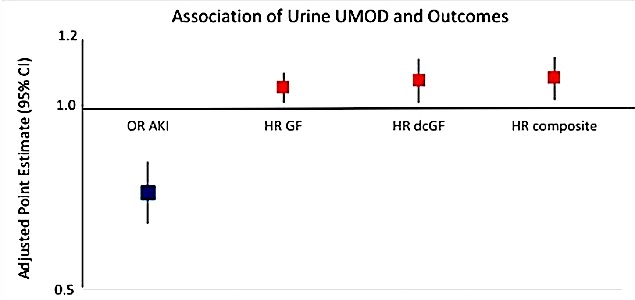Urine Uromodulin Associates with Deceased Donor Acute Kidney Injury and Allograft Failure
1Yale, New Haven, CT, 2University of Utah, Salt Lake City, UT, 3Perelman School of Medicine, University of Pennsylvania, Philadelphia, PA, 4Johns Hopkins University, Baltimore, MD, 5University of Michigan, Ann Arbor, MI
Meeting: 2019 American Transplant Congress
Abstract number: A161
Keywords: Cadaveric organs, Graft failure, Kidney transplantation, Outcome
Session Information
Session Name: Poster Session A: Biomarkers, Immune Monitoring and Outcomes
Session Type: Poster Session
Date: Saturday, June 1, 2019
Session Time: 5:30pm-7:30pm
 Presentation Time: 5:30pm-7:30pm
Presentation Time: 5:30pm-7:30pm
Location: Hall C & D
*Purpose: Produced exclusively by renal epithelial cells of the thick ascending limb, Uromodulin (UMOD, also known as Tamm-Horsfall protein) is the major component of hyaline casts and the most abundant urinary protein in healthy individuals. UMOD has immuno-modulatory functions, and its levels are also linked to nephron mass and renal tubular reserve. The role of UMOD in deceased donors and recipient outcomes has yet to be investigated.
*Methods: We measured UMOD levels from deceased-donor urine collected between 2010 to 2013 at organ procurement as part of the multicenter Deceased Donor Study to determine its association with donor acute kidney injury (AKI), recipient graft failure (GF: all-cause mortality, return to dialysis, or re-transplantation), and death-censored GF (dcGF). Out of 2430 total kidney recipients (1298 donors), we also performed detailed chart reviews for 1137 recipients at 13 centers to assess a composite outcome of GF or eGFR <20 ml/min/1.73m2at 1 year.
*Results: AKI occurred in 111 (9%) donors. Mean (95% CI) rates for GF, dcGF and the composite outcome were 66 (61-71), 33 (30-37) and 76 (66, 87) per 1000 patient-years, respectively. Compared to donors without AKI, UMOD concentrations were significantly and progressively lower in donors with increasing stages of AKI (median [IQR]: 2169 [1093, 4039], 1496 [763, 3481], 1415 [853, 3431], and 915 [258, 2669] ng/mL, p<0.01, respectively for no AKI, stage 1, 2 and 3). On multivariable analysis, each doubling of urine UMOD concentration was independently associated with 28% decreased risk for donor AKI [adjusted odds ratio, aOR (95% CI) 0.72 (0.64-0.81)] as shown in Figure. In contrast, each doubling of UMOD was independently associated with increased risk for GF and dcGF in recipients with adjusted hazard ratios (aHR) of 1.07 (1.01-1.13) and 1.10 (1.01-1.19), respectively. In the detailed sub-cohort, the aHR for the composite outcome was 1.11 (1.02, 1.21)] for each doubling of donor urine UMOD concentration.
*Conclusions: In this large cohort of deceased donors, those with AKI had lower urine UMOD levels, suggesting decreased production due to tubular injury. Mechanisms by which greater donor UMOD levels associated with modest increased risk for GF, dcGF and a composite of GF or poor allograft function are unclear but could be secondary to a heightened immune-activation state induced by UMOD in the recipients.
To cite this abstract in AMA style:
Mansour SG, Hall I, Reese P, Ashkar T, Jia Y, Thiessen-Philbrook H, Doshi M, Parikh CR. Urine Uromodulin Associates with Deceased Donor Acute Kidney Injury and Allograft Failure [abstract]. Am J Transplant. 2019; 19 (suppl 3). https://atcmeetingabstracts.com/abstract/urine-uromodulin-associates-with-deceased-donor-acute-kidney-injury-and-allograft-failure/. Accessed December 27, 2025.« Back to 2019 American Transplant Congress

